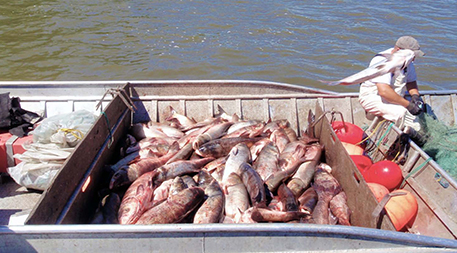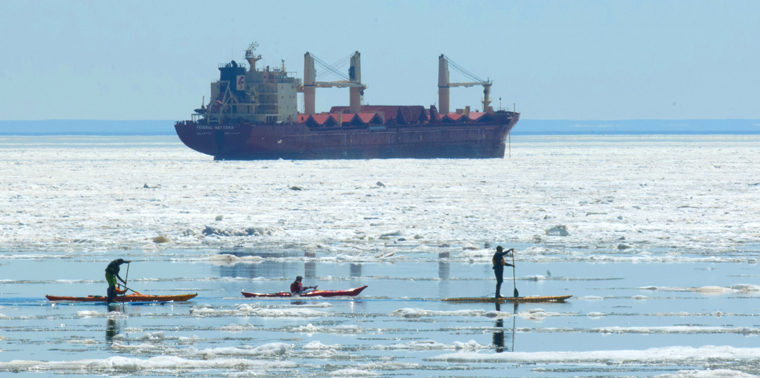June 13, 2017 — The St. Louis River, which flows into Lake Superior — the greatest of North America’s Great Lakes — has a long and turbulent history. Once a portal for Native American trade and a garden for wild rice, these waters that drain Minnesota’s north woods were polluted in the 19th and 20th centuries with waste from lumber, paper and steel production industries.
Today, state agencies and organizations are cleaning up the river by containing and removing contaminated sediments — but it’s not cheap. The river is emblematic of a broader fight across the Great Lakes to keep federal dollars flowing in to restore, protect and enhance the region.
The Great Lakes Restoration Initiative, led by the U.S. Environmental Protection Agency, is a major source of funds for the St. Louis River cleanup and similar projects. In 1987, the EPA included it among 43 “areas of concern” in the Great Lakes that had been degraded by generations of pollution. In 2010, the federal government launched GLRI to support rehabilitation efforts around the planet’s largest system of fresh surface water. Congress funded these projects into 2021, but the Trump Administration has proposed scrapping the program in its 2018 budget.

Great Lakes Restoration Initiative projects include cleaning up pollutants, controlling invasive species, restoring wetlands and more. Photo courtesy of Great Lakes Restoration Initiative (click to expand)
If GLRI is completely defunded, cleanups in eight states would be halted, including an initiative to restore wildlife habitats on the Buffalo River near Lake Erie, a project to reduce contamination of the Grand Calumet River in Indiana and an effort to restore water quality and biodiversity on the Cuyahoga River, which infamously caught fire in 1969 and spurred environmental legislation like the Clean Water Act. All told, GLRI has funded more than 3,000 projects to remove contaminants, prevent invasive species, reduce runoff and restore habitats.
Those engaged in cleanups say funding cuts would stymie progress on the St. Louis and other bodies of water. Kris Eilers, executive director of the nonprofit St. Louis River Alliance, says this would be a mistake.
“The return on investment per dollar [from GLRI] is incredible,” Eilers says. “It creates jobs, it cleans up the water. And when the cleanup work is done, nature can help itself.”

Among other projects, GLRI is helping control invasive Asian carp in the Illinois River, which connects to Lake Michigan via an artificial waterway. Photo courtesy of U.S. Government Accountability Office
In fact, the Brookings Institution reported in 2007 that restoring the Great Lakes would lead to at least US$50 billion in direct economic benefits from increased tourism, recreation, property values and business ventures.
Generations of Pollution
The St. Louis River is a perfect illustration of how generations of pollution can taint a wild space. The 3,584-square-mile (9,283-square-kilometer) watershed, which feeds into the twin ports of Duluth, Minnesota, and Superior, Wisconsin, at the westernmost tip of Lake Superior, was an important location for early Native American trade as well as a place to fish and grow wild rice. After the Europeans arrived in the 1600s, it became a dominant port for copper, iron ore and lumber.
As its shores developed, the river, like so many of the other bodies of water in the Great Lakes basin, was dramatically altered. It became a sewer for municipal and industrial pollution, and about 7,000 acres (3,000 hectares) of habitat were also dredged and filled to create the Duluth-Superior Port, according to the Minnesota Pollution Control Agency. Soon a whole generation of Minnesotans knew not to go swimming in the river’s mucky waters.
Despite increasing environmental regulations since the 1960s, much of the pollution in the river had already sifted down and settled in the riverbed sediment. Even as the Clean Water Act reduced pollution flowing into the lake, these sediments continue to threaten life in the river and along its banks.
“We’re counting on getting our state funding by leveraging that [federal] funding.” – Mike BaresMike Bares, a hydrogeologist with MPCA, has been working to clean up the St. Louis River since the 1990s. Efforts include excavating the riverbed and covering it with materials that suppress movement of the chemicals. These projects gained momentum after receiving support from GLRI in 2013 and are dependent on continued funding.
“All nine areas that MPCA is working on are hoping for funding from GLRI,” Bares says. “They will all be affected if the funding doesn’t come through. We’re counting on getting our state funding by leveraging that [federal] funding.”
Helping Local Economies
These cleanups aren’t just environmental progress — they have also spurred local economies. The community around the St. Louis River has already seen some signs of revitalization, says Suzanne Hanson, MPCA watershed unit manager in Duluth.
“We’re seeing a resurgence of kayaking and swimming,” Hanson says. “People never wanted to be on the river, but now it’s a pleasant place to be again.”
Similar comments could be made about thousands of other sites that dot the shores of these lakes, which easily rank among the world’s most magnificent. Whether that will continue to be the case only time — and federal funding — will tell. ![]()
Editor’s note: Rose Lundy produced this feature as a participant in the Ensia Mentor Program. Her mentor for the project was Brian Bienkowski.
Ensia shares solutions-focused stories free of charge through our online magazine and partner media. That means audiences around the world have ready access to stories that can — and do — help them shape a better future. If you value our work, please show your support today.
Yes, I'll support Ensia!

In addition, readers should know that other budget cuts proposed by the Trump administration would also mean great harm for the Great Lakes. The budget would wipe out a a separate funding program that helps states curb runoff pollution (Sec. 319 - see https://www.epa.gov/nps/319-grant-program-states-and-territories)
In addition, the president's proposed budget would slash environmental enforcement, hampering EPA's ability to protect our Lakes from polluters.
Furthermore, the Great Lakes are threatened not only by budget cuts but also proposed rollbacks of key measures to keep our water clean and safe. The Trump administration is already moving forward to dismantle limits on toxic dumping from power plants and protections for thousands of streams, many of which help feed the Great Lakes.
With summer now in full swing, we are reminded that the Great Lakes are where millions of Americans go to swim, fish, boat, or simply draw their drinking water.
If we want the Great Lakes to be clean, we'll need senators from both parties to demand full funding of all clean water programs and defense of the Clean Water Act.